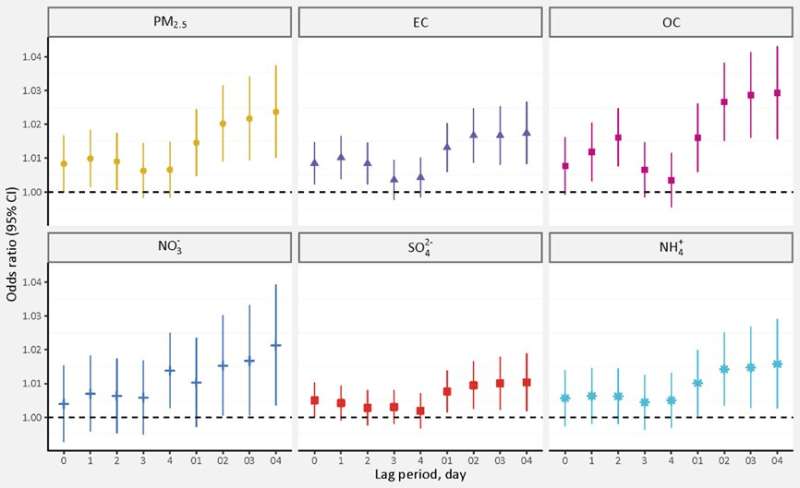Short-term exposure to fine particulate matter and mortality: Case-crossover evidence from 32 counties in China

A growing number of studies associate increased mortality with exposures to specific constituents of fine particulate matter (PM2.5), while great heterogeneity exists between locations. In China, evidence linking PM2.5 constituents and mortality was extensively sparse. This study primarily aimed to quantify short-term associations between PM2.5 constituents and non-accidental mortality among the Chinese population. It was led by Dr. Zhang (Department of Epidemiology and Biostatistics, School of Public Health, Wuhan University of Science and Technology).
This study collected daily mortality records from 32 counties in China between January 1, 2011, and December 31, 2013. Daily concentrations of main PM2.5 constituents (organic carbon [OC], elemental carbon [EC], nitrate [NO3- ], sulfate [SO42-], and ammonium [NH4+]) were estimated using the modified Community Multiscale Air Quality model. Time-stratified case-crossover design with conditional logistic regression models was adopted to assess mortality risks associated with short-term exposures to PM2.5 mass and its constituents. Stratification analyses were done by sex, age, and season.
A total of 116,959 non-accidental deaths were investigated. PM2.5 concentrations on the day of death were averaged at 75.7 µg/m3 (control day: 75.6 µg/m3), with an interquartile range (IQR) of 65.2 µg/m3. Per IQR rise in PM2.5, EC, OC, NO3-, SO42-, and NH4+ at lag-04 day was associated with an increase in non-accidental mortality of 2.4% (95% confidence interval, 1.0–3.7), 1.7% (0.8–2.7), 2.9% (1.6–4.3), 2.1% (0.4–3.9), 1.0% (0.2–1.9), and 1.6% (0.3–2.9), respectively. Both PM2.5 mass and its constituents were strongly associated with elevated cardiovascular mortality risks, but only PM2.5, EC, and OC were positively associated with respiratory mortality at lag-3 day. PM2.5 mass and its constituents' associated effects on mortality varied among sex- and age-specific subpopulations. Differences in the seasonal pattern of associations exist among PM2.5 constituents, with stronger effects related to EC and NO3- in warm months but SO42- and NH4+ in cold months.
This study suggested that short-term exposures to PM2.5 compositions were positively associated with increased risks of mortality, particularly those constituents from combustion-related sources. In conclusion, this study contributes to an in-depth understanding of the acute health effects of short-term exposure to PM2.5 and its constituents in moderate to severe pollution scenarios. It provides essential evidence support for a comprehensive assessment of the death burden caused by particulate matter constituents.
The research was published in Science China Life Sciences.
More information: Peixuan Zhou et al, Short-term exposure to fine particulate matter constituents and mortality: case-crossover evidence from 32 counties in China, Science China Life Sciences (2022). DOI: 10.1007/s11427-021-2098-7



















